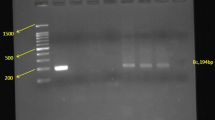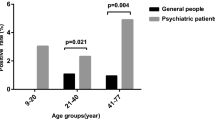Abstract
Previous studies have demonstrated that latent toxoplasmosis is associated with neuropsychiatric disorders. We evaluated the correlation between Toxoplasma gondii infection and prenatal depression. In this case–control study, we enrolled 116 depressed pregnant women and 244 healthy controls. The Edinburgh Postpartum Depression Scale (EPDS) was used to evaluate the depression symptom severity in study participants. All participants were screened for the anti-Toxoplasma IgG by enzyme-linked immunosorbent assay. Seroprevalence of T. gondii did not significantly differ between the depressed pregnant women and healthy controls (OR = 1.4; 95 % CI = 0.9–2.19; P = 0.142). T. gondii IgG titer was significantly higher in depressed women (18.6 ± 10.9 IUs) than those in the control group (13.6 ± 8.1 IUs) (z = −5.36, P < 0.001). The T. gondii–positive depressed women showed a positive correlation of T. gondii IgG titer with the EPDS scores (r = 0.52; P < 0.01). The mean EPDS score was also significantly higher in the T. gondii–positive depressed women (20.7 ± 2.7) compared with the controls (18.36 ± 2.7) (P < 0.001). The results obtained from the current study revealed that T. gondii infection might affect susceptibility to depression and severity of depressive symptoms in pregnant women, particularly in those patients who have high antibody titers. Further study is required to fully elucidate the characteristics and mechanisms of this association.


Similar content being viewed by others
References
Montoya J, Liesenfeld O (2004) Toxoplasmosis. Lancet 363:1965–1976
Flegr J, Prandota J, Sovičková M, Israili ZH (2014) Toxoplasmosis—a global threat. Correlation of latent toxoplasmosis with specific disease burden in a set of 88 countries. PLoS One 9:e90203
Nourollahpour Shiadeh M, Niyyati M, Fallahi S, Rostami A (2016) Human parasitic protozoan infection to infertility:a systematic review. Parasitol Res 115:469–477
Rostami A, Keshavarz H, Shojaee S, Mohebali M, Meamar AR (2014) Frequency of Toxoplasma gondii in HIV positive patients from West of Iran by ELISA and PCR. Iran J Parasitol 9:474–481
McConkey GA, Martin HL, Bristow GC, Webster JP (2013) Toxoplasma gondii infection and behaviour—location, location, location? J Exp Biol 216:113–119
Webster JP, McConkey GA (2010) Toxoplasma gondii-altered host behaviour: clues as to mechanism of action. Folia Parasitol 57:95–104
Flegr J (2013) Influence of latent Toxoplasma infection on human personality, physiology and morphology: pros and cons of the Toxoplasma–human model in studying the manipulation hypothesis. J Exp Biol 216:127–133
Arias I, Sorlozano A, Villegas E et al (2012) Infectious agents associated with schizophrenia: a meta-analysis. Schizophr Res 136:128–136
Sutterland A, Fond G, Kuin A et al (2015) Beyond the association. Toxoplasma gondii in schizophrenia, bipolar disorder, and addiction: systematic review and meta-analysis. Acta Psychiatr Scand 132(3):161–179. doi:10.1111/acps.12423
Ling VJ, Lester D, Mortensen PB, Langenberg PW, Postolache TT (2011) Toxoplasma gondii seropositivity and suicide rates in women. J Nerv Ment Dis 199:440–444
Hinze-Selch D, Däubener W, Erdag S, Wilms S (2010) The diagnosis of a personality disorder increases the likelihood for seropositivity to Toxoplasma gondii in psychiatric patients. Folia Parasitol 57:129–135
Pearce BD, Kruszon-Moran D, Jones JL (2012) The relationship between Toxoplasma gondii infection and mood disorders in the third National Health and Nutrition Survey. Biol Psychiatry 72:290–295
Miman O, Kusbeci OY, Aktepe OC, Cetinkaya Z (2010) The probable relation between Toxoplasma gondii and Parkinson’s disease. Neurosci Lett 475:129–131
Miman O, Mutlu EA, Ozcan O, Atambay M, Karlidag R, Unal S (2010) Is there any role of Toxoplasma gondii in the etiology of obsessive–compulsive disorder? Psychiatry Res 177:263–265
Torrey EF, Bartko JJ, Yolken RH (2012) Toxoplasma gondii and other risk factors for schizophrenia: an update. Schizophr Bull 38:642–647
Groer MW, Yolken RH, Xiao J-C et al (2011) Prenatal depression and anxiety in Toxoplasma gondii-positive women. Am J Obstet Gynecol 204(433):e1–e7
Markovitz AA, Simanek AM, Yolken RH et al (2015) Toxoplasma gondii and anxiety disorders in a community-based sample. Brain Behav Immun 43:192–197
Hamdani N, Daban-Huard C, Lajnef M et al (2013) Relationship between Toxoplasma gondii infection and bipolar disorder in a French sample. J Affect Dis 148:444–448
Pedersen MG, Mortensen PB, Norgaard-Pedersen B, Postolache TT (2012) Toxoplasma gondii infection and self-directed violence in mothers. Arch Gen Psychiatry 69:1123–1130
Mazhari S, Nakhaee N (2007) Validation of the Edinburgh postnatal depression scale in an Iranian sample. Arch Womens Ment Health 10:293–297
Montazeri A, Torkan B, Omidvari S (2007) The Edinburgh Postnatal Depression Scale (EPDS): translation and validation study of the Iranian version. BMC Psychiatry 7:11
Cox JL, Holden JM, Sagovsky R (1987) Detection of postnatal depression. Development of the 10-item Edinburgh Postnatal Depression Scale. Br J Psychiatry 150:782–786
Murray D, Cox JL (1990) Screening for depression during pregnancy with the Edinburgh Depression Scale (EDDS). J Reprod Infant Psychol 8:99–107
Sadock BJ, Sadock VA (2008) Kaplan & Sadock’s concise textbook of clinical psychiatry, vol 2008, 3rd edn. Lippincott Williams & Wilkins, Philadelphia, p 201
Gaynes BN, Gavin N, Meltzer-Brody S, et al (2005) Perinatal depression: prevalence, screening accuracy, and screening outcomes. Online at http://www.ahrq.gov/clinic/epcsums/peridepsum.htm
Wang X, Zhang L, Lei Y et al (2014) Meta-analysis of infectious agents and depression. Sci Rep 4:4530
Benros ME, Waltoft BL, Nordentoft M et al (2013) Autoimmune diseases and severe infections as risk factors for mood disorders: a nationwide study. JAMA Psychiatry 70:812–820
Hinze-Selch D, Däubener W, Eggert L, Erdag S, Stoltenberg R, Wilms S (2007) A controlled prospective study of Toxoplasma gondii infection in individuals with schizophrenia: beyond seroprevalence. Schizophr Bull 33:782–788
Arling TA, Yolken RH, Lapidus M et al (2009) Toxoplasma gondii antibody titers and history of suicide attempts in patients with recurrent mood disorders. J Nerv Ment Dis 3:905–908
Cetinkaya Z, Yazar S, Gecici O, Namli MN (2007) Anti-Toxoplasma gondii antibodies in patients with schizophrenia—preliminary findings in a Turkish sample. Schizophr Bull 33:789–791
Hamidinejat H, Ghorbanpoor M, Hosseini H et al (2010) Toxoplasma gondii infection in first-episode and inpatient individuals with schizophrenia. Int J Infect Dis 14:e978–e981
Kar N, Misra B (2004) Toxoplasma seropositivity and depression: a case report. BMC Psychiatry 4:1
Berenreiterova M, Flegr J, Kubena AA, Nemec P (2011) The distribution of Toxoplasma gondii cysts in the brain of a mouse with latent toxoplasmosis: implications for the behavioral manipulation hypothesis. PLoS One 6:e28925
Haroon F, Händel U, Angenstein F et al (2012) Toxoplasma gondii actively inhibits neuronal function in chronically infected mice. PLoS One 7:e35516
Hsu PC, Groer M, Beckie T (2014) New findings: depression, suicide, and Toxoplasma gondii infection. J Am Assoc Nurse Pract 26:629–637
Kohl C, Walch T, Huber R et al (2005) Measurement of tryptophan, kynurenine and neopterin in women with and without postpartum blues. J Affect Disord 86:135–142
Stowe ZN, Hostetter A, Newport DJ (2005) The onset of postpartum depression: implications for identification in obstetrical and primary care. Am J Obstet Gynecol 192:522–526
Wasserman EE, Nelson K, Rose NR et al (2009) Infection and thyroid autoimmunity: a seroepidemiologic study of TPOaAb. Autoimmunity 42:439–446
Lazarus J, Hall R, Othman S et al (1996) The clinical spectrum of postpartum thyroid disease. Q J Med 89:429–435
Acknowledgments
The authors are very thankful to the staff of the prenatal health care centers of Shahid Beheshti University of Medical Sciences, especially Miss Khademi, for their kind assistance in sample collection. Most importantly, the authors would like to thank all the participants in this study. We are thankful for the collaboration of the Protozoology unit of the Shahid Beheshti University of Medical Sciences.
Author information
Authors and Affiliations
Corresponding author
Ethics declarations
All procedures performed in studies were in accordance with the ethical standards of the institutional and/or national research committee and with the 1964 Declaration of Helsinki and its later amendments or comparable ethical standards
Conflict of interest
Dr. Newport has received research support from Eli Lilly, Glaxo SmithKline (GSK), Janssen, the National Alliance for Research on Schizophrenia and Depression (NARSAD), the National Institutes of Health (NIH), and Wyeth. He has served on speakers’ bureaus and/or received honoraria from Astra–Zeneca, Eli Lilly, GSK, Pfizer, and Wyeth. He has served on advisory boards for GSK. He has never served as a consultant to any biomedical or pharmaceutical corporations. Neither he nor family members have ever held equity positions in biomedical or pharmaceutical corporations. None of the other authors have any conflict of interest.
Informed consent
Informed consent was obtained from all individual participants included in the study.
Rights and permissions
About this article
Cite this article
Nourollahpour Shiadeh, M., Rostami, A., Pearce, B.D. et al. The correlation between Toxoplasma gondii infection and prenatal depression in pregnant women. Eur J Clin Microbiol Infect Dis 35, 1829–1835 (2016). https://doi.org/10.1007/s10096-016-2734-5
Received:
Accepted:
Published:
Issue Date:
DOI: https://doi.org/10.1007/s10096-016-2734-5




